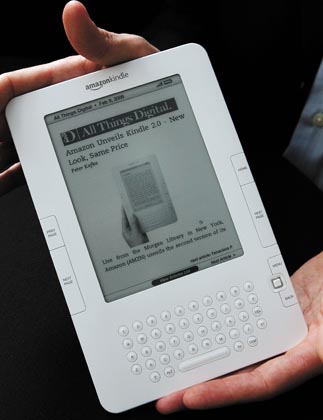Koreans embrace e-books due to tablet PC boom

The Amazon Kindle, a poplular e-book reader developed by Amazon.com subsidiary Lab126 [JoongAng Ilbo]
The last option is getting more and more popular. As more people own devices capable of being used as e-book readers, including tablet computers and smartphones, along with a mushrooming of electronic content, the digital book business is booming.
According to the latest report from the Association of American Publishers, electronic book sales in U.S. totaled $90.3 million in February. That’s a watershed: e-books are now the most popular publishing format in the U.S. for the first time, overtaking paperbacks, which had revenues of $81.2 million in February.
The AAP attributed the growth in February to the greater number and variety of devices and the broader range of e-books available.
Amazon.com, the largest online retailer in the U.S., said last week it sells 105 e-books for every 100 print books, excluding free e-books. The company’s e-book business has grown steadily since it introduced the Kindle e-book device in 2007. And Amazaon recently rolled out the cheapest version of its Kindle, priced at just $114.
As America goes, so does Korea.
According to the Korea Electronic Publishing Association, the Korean electronic book market will likely surpass the 200 billion won ($184 million) level for the first time this year. And domestic publishing companies are more aggressive than ever in going digital.
“Before, the Korean e-book market was lackluster, mainly because there wasn’t much manpower and resources invested in converting print books to e-books,” said Jeong Seok-won, strategy and planning director at iRiver, a Korean electronics firm. “But we are seeing more drive for growth, as publishers realize a profit structure that works to their advantage.”
Analysts say the biggest change in the market came with the release of the Apple iPad in April 2010 and the follow-up release of local tablet computers.
Previously, the business revolved around dedicated e-book reading devices, which had no other functions. But reading an e-book on a tablet computer or smartphone is different, because other functions of the machine can be integrated into the reading experience.
The best example is Ridi Books, one of the top-selling e-book applications for both Apple mobile devices and those using Google’s Android operating systems. This program’s selling point is its marriage with social networking services. If users come upon a paragraph or fact they want to share, they can copy and post it to Twitter or Facebook.
“We plan to further expand the app’s capabilities by adding functions like recommending books to users based on what they read, shared and made notes about,” said Bae Ki-sik, the head of Ridi Books.
KT, Korea’s No. 2 mobile carrier, launched last year a massive e-book content store dubbed Qook Book Cafe, the first mobile carrier to do so. This year it renovated the service, and held a contest for amateur writers to promote the service.
Traditional bookstores are also eying the e-book market: Kyobo Bookstore, the country’s largest bookstore chain, was one of the earliest, pre-loading its e-book app onto a Samsung smartphone, among others. Yes24, an online bookstore, also introduced a free e-book app.
Education businesses like Kyowon, Daekyo and Woongjin ThinkBig, are jumping on the bandwagon, too, releasing children’s books and textbooks into paid apps. Some include audio and 3-D capabilities.
By Shim Jae-woo, Kim Hyung-eun [hkim@joongang.co.kr]
한글 관련 기사 [중앙일보]
전자책 매출, 종이책 앞질렀다
애플 아이패드와 같은 태블릿PC의 보급이 확산하면서 전자책 시장이 급성장하고 있다. 다양한 서비스의 ‘애플리케이션 북(이하 앱북)’이 잇따라 출시되면서 출판시장의 판도를 바꿔가는 중이다.
미국출판협회(AAP)는 지난 2월 한 달간 출판시장 매출을 분석한 결과 미국 내 전자책 매출이 9030만 달러(약 977억원)를 기록하면서 사상 처음 종이책 매출(8120만 달러)을 넘어섰다고 발표했다. 지난해 2월 미국시장에서 전자책 매출(2890만 달러)과 비교하면 1년 새 무려 3배 이상 증가한 것이다.
세계 최대 인터넷서점인 아마존닷컴 또한 지난달 1일부터 종이책 100권이 팔릴 때마다 전자책은 105권이 팔리고 있다고 밝혔다. 전자책 판매량 가운데 무료 내려받기는 제외됐다. 아마존닷컴은 지난달 기존의 킨들보다 25달러 싼 대신 광고가 삽입된 114달러짜리 저가 킨들을 선보였다.
국내 전자책 시장도 마찬가지다. 한국전자출판협회는 교보문고·예스24 등의 추정 통계를 합산한 결과 올해 전자책 시장이 사상 최초로 2000억원을 돌파할 것으로 내다봤다.
사정이 이렇다 보니 출판업자들도 종이책의 디지털화 작업에 적극 뛰어들고 있다. 아이리버의 정석원 전략기획팀장은 “예전에는 종이책을 전자책으로 전환하는 인력이 없어 전자책 출판 시장이 미미했지만 전자책 시장이 급속히 커지는 와중에 직접 전자책을 출판하면 수익배분이 달라진다는 점을 알게 되면서 활기를 띠고 있다”고 말했다. 저작권을 가진 전자책을 직접 출판하면 매출의 60∼70%를 가져갈 수 있지만 남에게 맡기면 수익배분이 50% 정도로 줄어든다는 것이다. 1년 새 전자책 시장이 급성장한 배경에는 지난해 4월 출시된 아이패드를 비롯해 태블릿PC의 보급 확대를 빼놓을 수 없다.
과거 전자책 시장은 e북 단말기 중심의 사업이 기반이 됐으나 이제는 단말기가 아닌 차별화된 콘텐트와 서비스 제공으로 경쟁 양상이 바뀌었다.
전자책 서비스 앱인 리디북스가 대표적이다. 아이폰iOS와 구글 안드로이드 운영 체제를 기반으로 앱북 누적 다운로드 1위를 기록하고 있다. 소셜네트워크서비스(SNS)와 연동한 ‘소셜 e북’이라는 서비스가 차별화 포인트다. ‘소셜 e북’ 서비스는 리디북스 사용자가 책을 읽다가 지인들과 공감하고 싶은 글귀가 있으면 긁어서 트위터나 페이스북, e-메일로 바로 보낼 수 있다. 책갈피 기능과 궁금한 내용을 바로 검색할 수 있는 백과사전 기능이 있고, 또 메모하고 싶은 내용을 긁어서 저장할 수도 있다. 리디북스 배기식 대표는 “SNS에서 친구가 읽은 책, 친구가 강조한 내용 등을 파악해 친구가 관심을 가질 만한 도서를 추천하는 기능까지 확대할 예정”이라고 밝혔다.
전통 서점가 역시 앱북을 선보이며 전자책 사업을 확장하고 있다. 교보문고는 다른 전통 서점들을 제치고 일찌감치 ‘교보 e 북’ 사업을 진행했다. 삼성전자 스마트폰에 교보문고 앱을 탑재하는 등 활발한 마케팅 활동을 벌였다. 온라인 서점 기반의 ‘예스 24’ 또한 앱북을 무료로 배포하고 콘텐트를 다양화했다.
비단 서점가만이 아니다. KT는 지난해 말 앱북인 ‘쿡북카페’를 선보였다. 이후 올해 초 ‘올레e북’으로 새롭게 단장하며 신진 작가 발굴을 위한 공모전을 실시했다. 교원·대교·웅진씽크빅 등 국내 대형 교육출판업체들도 영·유아기 아이들이 보는 동화책이나 교재 한 권을 앱북 형태로 만들어 유료로 팔고 있다. 이들이 만든 교육용 앱북은 3D(3차원)와 음원까지 포함하고 있다.










with the Korea JoongAng Daily
To write comments, please log in to one of the accounts.
Standards Board Policy (0/250자)